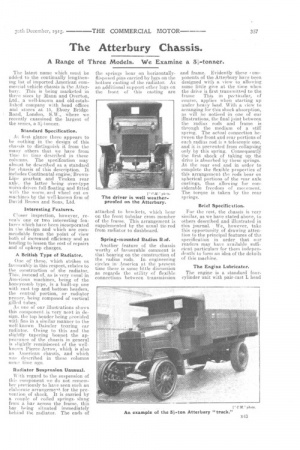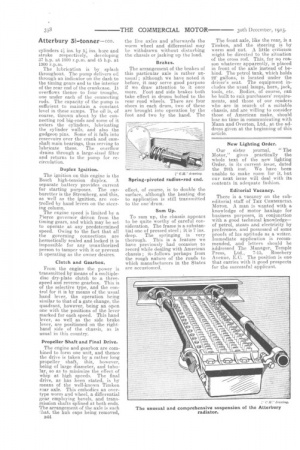The Atterbury Chassis.
Page 33

Page 34

If you've noticed an error in this article please click here to report it so we can fix it.
A Range of Three Models. We Examine a 5!,-tonner.
The latest name which must be added to the continually lengthening list of imported American commercial vehicle chassis is the Atterbury. This is being marketed in three sizes by Mann and Overton, Ltd., a well-known and old-established company with head offices and stores at 15, Ebury Bridge Road, London, S.W., where. -we . recently examined the largest of the series, a 31-tonner.
Standard Specification.
At first glance thereappears to be nothing in the design of this chassis to distinguish it from the Many others that we have from time to time described in the-se Columns. The specification may almostbe described as a standard for chassis of this description. It includes Continental engine, BrownLine gearbox and Timken rear axle, • the tatter being over-type worm-driven full-floating and fitted with the worm, aad wheel cut on machines by the welI-knOwn firm of David Brown and Sons, Ltd.
Interesting Features.
Closer inspection, however, reveals' one or two interesting • fea, tures which have been incorporated in the design and which are commendable from the point of view both -of increased efficiency and as tending to-lessen the cost of repairs and of upkeep charges. .
A British. Type cif Radiator.
One, of these, which strikes us favourably in this respect., relates to the construction of the radiator. This, instead of, as is very usual-in American machines, being of the honeycomb 'type, is a built-up one with east top and .bottom headers, the central portion, or radiator proper, being composed of vertical gilled tubes.'
As one of our illustrations shows this component is very neat in design, the top header beingprovided with fins in a similar manner to the well-known . Daimler touring ear radiator. Owing to this and the slightly tapering bonnet the appearance of the chassis in general is slightly reminiscent of the wellknown Pierce-Arrow, which is also an American chassis, and which was described in these columns some time ago.
Radiator Suspension Unusual.
With regard to the suspension of this component we de not remember previously to have seen such an elaborate arrangement for the prevention of shock. It is carried by a couple of coiled springsslung from a bar across the frame, this bar being situated immediately behind ths. radiator. The ends of
the springs bear on horizontallygispused pins carried by lugs on the bottom casting of the radiator. As an additional support other lugs on the front -of this casting are attached to brai,kets, which bear on the front tubular cross Member of the frame. This arrangement is supplemented by the usual tie-rod from radiator to dashboard.
Spring-mounted Radius Rid.
• Another feature of the chassis worthy, of favourable' comment is that bearing on the construction of the radius rods," In. engineering Circles in America at the present time there is sonic little discussion as regards the utility of flexible connections between transmission
and frame. Evidently these onaponents of the Atterbury have been designed with a view to allowing some little give at the time when the drive is first transmitted to the triune This, in pc$1-a.iular, of course, applies when starting up under heavy lead. With a view to arranging for this shock absorption, as will he noticed in one of our illustrations, the final joint between the radius rods and frame is through the medium of a stiff spring. The actual -connection between the front and rear portions of each radius rod is A telescopic one, and it is prevented from collapsing only by this spring. Consequently the first shock of taking up the drive is absorbed by these springs. At the rear end and in order to complete the flexible properties of this arrangement the rods bear on spherical portions of the rear axle castings, thus allowing for considerable freedom of movement. The torque is taken by the rear Springs.
Brief Specific 4.1 ion.
For the rest, the chassis is very similar, as we have stated above, to others described and illustrated in this journal. We, however, take this opportunity of drawing attention to the principal features of the specification in order that our readers may have available sufficient particularS for them independently to form an idea of the details of this machine, The Engine Lubricator.
The engine is a standard fourcylinder unit with pair-cast L head
cylinders 4:12 ins. by 51 ins, bore and stroke respectively, developing 37 h.p. at 1000 r.p.m. and 45 h.p. at 1300 r.p.m.
The lubrication is by splash throughout. The pump delivers oil through an indicator on the dash to the timing gears and to the interior of the rear end of the crankcase. It overflows thence to four troughs, one under each of the connecting rods. The capacity of the pump is sufficient to maintain a constant level in these sumps. The oil is, of course, thrown about by the connecting rod big-ends and some of it enters the cylinders, lubricating the cylinder walls, and also the gudgeon pins. Some of it falls into reservoirs over the crank and camshaft main bearings, thus serving to lubricate these. Theoverflow drains through a large-sized filter and returns to the pump for recirculation.
Duplex Ignition.
The ignition on this engine is the Bosch high-tension duplex. A separate .battery provides current for starting purposes. The carburetter is the Stromberg, and this, as well as the ignition, are controlled by hand levers on the steering column.
The engine speed is limited by a Pierce governor driven from the timing gears, and which may be set to operate at any predeterniined speed. Owing to the fact that all the governing connections are hermetically sealed and locked it is impossible for any unauthorized person to tamper with it or prevent it operating as the owner desires.
Clutch and Gearbox, From the engine the power is transmitted by means of a multipledisc dry-plate clutch to a threespeed and reverse gearbox. This is of the selective type, and the control for it is by means of the usual hand lever, the operation being similar to that of a gate change, the quadrant, however, being an open one with the positions of the lever marked for each speed. This hand lever, as well as the side brake lever, are positioned on the righthand side of the chassis, as is usual in this country.
Propeller Shaft and Final Drive.
The engine and gearbox are combined to form one unit, and thence the drive is taken by a rather long propeller shaft, this, however, being of large diameter, and tubular, so as to minimize the effect of whip at high speeds. The final drive, as has been stated, is by means of the well-known Timken roar axle. This embodies an overtype worm arid wheel, a differential gear employing bevels, and transmission shafts splined at both ends. The arrangement of the axle is such hat. the hub caps being removed, B44 the live axles and afterwards the worm wheel and differential may be withdrawn without disturbing the chassis or jacking up the load.
Brakes.
The arrangement of the brakes of this particular axle is rather unusual; although we have noted it before, it may serve good purpose if we draw attention to it once more. Foot and side brakes both take effect in drums bolted to the rear road wheels. There are four shoes in each drum, two of these are brought into operation by the foot and two by the hand. The effect, of course, is to double the surface, although the heating due to application is still transmitted to the one'drum.
Sum Up.
To sum up, the chassis appears to be quite worthy of careful consideration. The frame is a. substantial one of pressed. steel ; it is 7 ins. deep. The springing is very thorough. This is a feature we have previously had . occasion to record while dealing with American chassis; itp, follows perhaps from the rough nature of the roads to which manufacturers in the States are accustomed.
The front axle, like the rear, is a Timlien, and the steering is by werm and nut. A little criticism might be directed to the situation of the cross rod. This, for no reason whatever apparently, is placed in front of the axle instead of behind. The petrol tank, which holds 22' gallons, is located under the driver's seat. The equipment includes the usual lamps, horn, jack, tools, etc. Bodies, of course, can he built to suit purchasers' requirements, and those of our readers who are in search of a suitable chassis, and are willing to consider those of American make, should lose no time in communicating with Mann and Overton, Ltd., at the address given at the beginning of this article.
New Lighting Order.
Our sister journal, " The Motor," gives practically the whole text of the new lighting Order, in its current issue, dated the 28th inst. We have been unable to make room for it, but our next issue will deal with its contents in adequate fashion.
Editorial Vacancy.
There is a vacancy on the subeditorial staff Of TEE COMMERCIAL MOTOR. A man is wanted with a knowledge of motor haulage for business purposes, in conjunction with a good technical knowledge— of petrol, steani and electricity by preference.. and possessed of some proofs of his aptitude as a writer. Immediate application is recommended, and letters should be -addressed The Manager, Temple Press, Ltd., 7-15, Rosebery Avenue, E.G. The position is one that carries with it good prospects for the successful applicant.








































